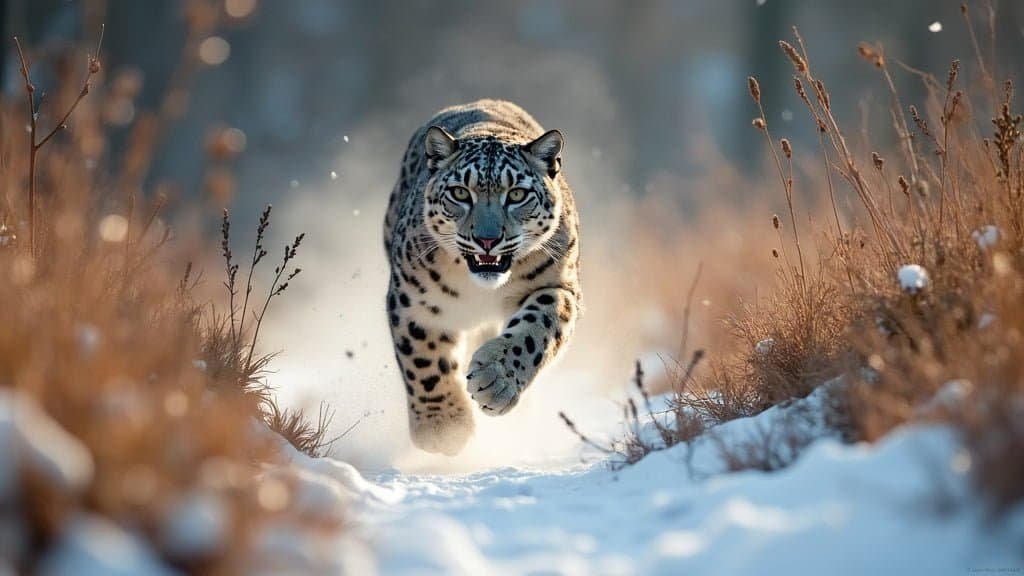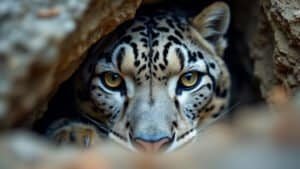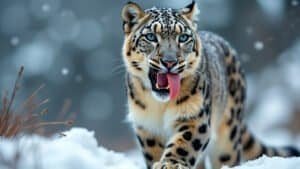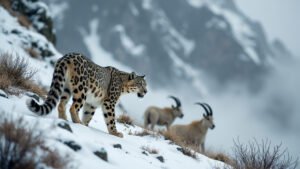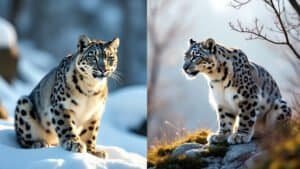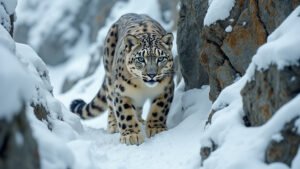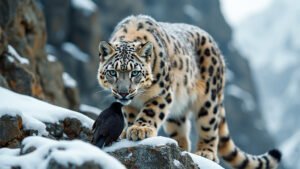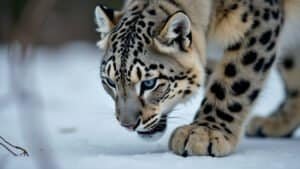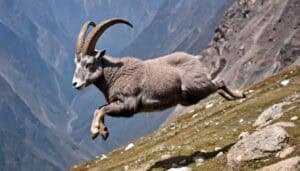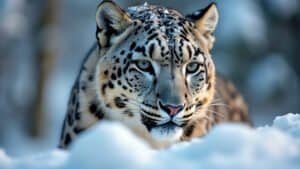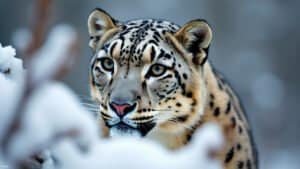Introduction
Snow leopards are elusive and powerful predators known for their incredible hunting skills. This article delves into the various techniques snow leopards use to capture and kill their prey, leveraging their environment and physical prowess
We will explore how these majestic cats stalk and approach their prey, the types of animals they hunt, and the methods they employ to make a successful kill. Understanding these aspects provides insight into the survival strategies of one of the world’s most fascinating big cats
Techniques Snow Leopards Use to Stalk Their Prey
Snow leopards, with their elusive nature and incredible stealth, are masters of the art of stalking. Their ability to blend seamlessly into their environment and approach prey undetected is critical to their hunting success
This section examines the key techniques snow leopards use to stalk their prey, ensuring they can get close enough for a successful kill
Using Stealth and Silence
Snow leopards rely heavily on their ability to move silently and remain unnoticed
Their thick fur, which provides insulation against the cold, also helps muffle the sound of their movements. This fur extends to their large paws, which act like snowshoes, distributing their weight evenly and allowing them to walk silently on snow
A study published in “The Journal of Mammalogy” highlights that snow leopards can remain completely silent even when navigating through rocky and uneven terrain
Approaching from Higher Ground
One of the most effective strategies employed by snow leopards is using the mountainous terrain to their advantage. They often position themselves on higher ground, using their keen eyesight to spot potential prey from a distance
Once a target is identified, they carefully descend, using the natural cover provided by rocks and vegetation to remain hidden. According to research from the Snow Leopard Trust, this method allows them to get within striking distance without being detected
Timing the Attack
Patience is a virtue for snow leopards. They may spend several hours or even days tracking a herd of prey animals, waiting for the perfect moment to strike. They prefer to attack when the prey is most vulnerable, such as during feeding or resting periods
This calculated approach minimizes the energy expended during the hunt and maximizes the chances of a successful kill. Studies have shown that snow leopards are more successful hunters during early morning and late evening, times when their prey is less alert
Using the Environment to Their Advantage
Snow leopards are adept at utilizing their harsh and rugged environments to enhance their hunting success. Their physical adaptations and strategic use of the terrain enable them to be effective predators in some of the most challenging habitats on Earth
Camouflage in Snowy Terrain
The snow leopard’s fur is its most distinctive and essential adaptation for camouflage. The pale, smoky-gray coat, patterned with rosettes and spots, blends perfectly with the rocky, snowy landscapes of their habitat
This natural camouflage allows them to remain almost invisible to their prey. A study published in “Biological Conservation” noted that the snow leopard’s camouflage significantly reduces detection by prey, giving them a critical advantage during the hunt
Navigating Rocky Landscapes
Snow leopards are built for navigating the steep and rocky terrains of their mountainous homes. Their powerful hind legs enable them to leap distances of up to 50 feet, allowing them to traverse cliffs and rocky outcrops with ease
Their long, thick tail provides balance and agility, helping them maneuver sharp turns and sudden drops. This ability to move quickly and efficiently through such challenging landscapes is crucial for both stalking prey and avoiding detection
Utilizing Snow Cover
Snow leopards also make strategic use of snow cover to aid in their hunting. They often follow prey tracks in the snow, which helps them locate and approach their targets without being seen
Additionally, the snow provides a soft surface that dampens the sound of their movements, making it easier to move silently. Research indicates that snow leopards are more successful in their hunts during winter months when snow cover is abundant, as it allows them to get closer to their prey undetected
Types of Prey Snow Leopards Hunt
Snow leopards have a diverse diet, primarily consisting of medium to large-sized ungulates found in their mountainous habitat. Their prey selection is influenced by availability, season, and the environment
This section explores the various types of prey snow leopards hunt and the strategies they use to capture them
Mountain Goats and Sheep
The primary prey for snow leopards are mountain goats and sheep, such as the Himalayan blue sheep (bharal) and the Siberian ibex. These animals are well-adapted to the rocky terrain, making them challenging but rewarding targets
Snow leopards use their stealth and agility to close in on these nimble creatures, often ambushing them from above. According to a study by the Wildlife Conservation Society, these ungulates make up a significant portion of the snow leopard’s diet, especially in areas where they are abundant
Small Mammals and Birds
In addition to larger prey, snow leopards also hunt smaller mammals and birds. These include marmots, pikas, hares, and various bird species. Small mammals are particularly important during times when larger prey is scarce
Snow leopards are opportunistic hunters, and their ability to adapt their diet to include smaller animals helps ensure their survival. Research published in “Oryx” journal indicates that in some regions, small mammals can constitute up to 20% of the snow leopard’s diet
Seasonal Variations in Diet
The diet of snow leopards can vary seasonally based on prey availability. During summer months, when ungulates move to higher altitudes, snow leopards may rely more on smaller mammals
Conversely, in winter, when snow drives prey animals to lower elevations, snow leopards may have easier access to larger prey. This seasonal adaptability is crucial for their survival in the harsh and variable climates of their habitat
A study in “Ecological Applications” highlights the snow leopard’s dietary flexibility as a key factor in their ability to thrive in diverse environments
How Snow Leopards Kill Their Prey
The process by which snow leopards kill their prey is a testament to their strength, skill, and efficiency as hunters. This section delves into the methods snow leopards use to ensure a successful kill and how they consume their catch
Methods of Killing
Snow leopards typically employ two main methods to kill their prey: strangulation and a powerful bite to the neck. When attacking larger prey, such as mountain goats and sheep, they aim for the neck and throat, using their strong jaws and sharp teeth to deliver a lethal bite
This method quickly incapacitates the prey by severing major blood vessels or suffocating them. Smaller prey, like marmots and hares, are usually killed with a swift bite to the neck or head
According to research published in the “Journal of Zoology,” these techniques are highly effective and ensure that the prey is killed quickly, reducing the risk of injury to the snow leopard
Ensuring a Quick Death
Snow leopards are highly efficient hunters, and ensuring a quick kill is essential for their survival. A prolonged struggle could attract other predators or scavengers, posing a threat to the snow leopard and its meal
By swiftly subduing their prey, snow leopards minimize the risk of losing their catch and conserve energy. This efficiency is particularly important in the harsh mountainous environments they inhabit, where food can be scarce and hunting opportunities infrequent
Consuming the Kill
Once the prey is killed, snow leopards typically drag the carcass to a secluded location to eat. They often consume the kill in stages, covering the remains with snow or rocks to hide it from scavengers and returning to feed over several days
This behavior is crucial for maximizing their food intake, especially in regions where prey is not abundant. Studies by the Snow Leopard Trust have shown that snow leopards can take several days to consume a large kill, providing them with sustained energy over an extended period
Conclusion
Snow leopards are extraordinary hunters, utilizing a combination of stealth, strength, and environmental advantages to capture and kill their prey
Their ability to blend into the snowy, rocky terrain and their strategic use of higher ground give them a significant edge in stalking. By understanding their primary prey types and the various methods they use to make a kill, we gain insight into the snow leopard’s survival tactics
Despite the harsh conditions of their habitat, snow leopards are highly effective predators, ensuring their place at the top of the food chain in the rugged mountains they call home
